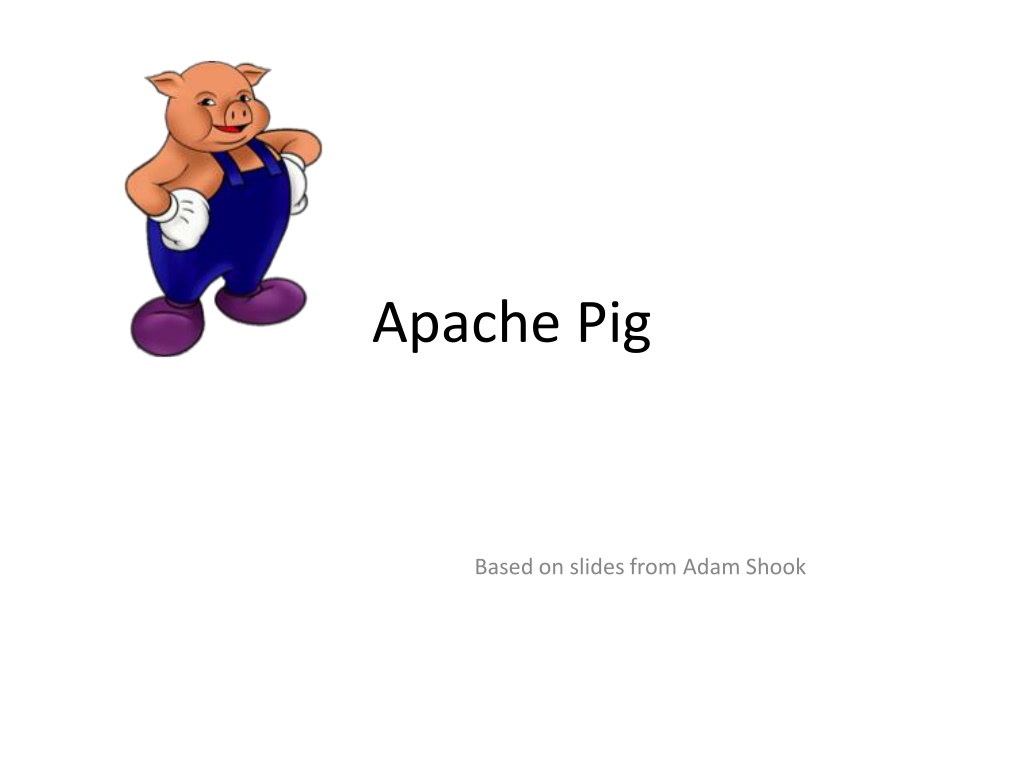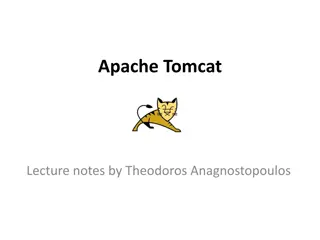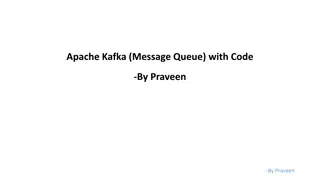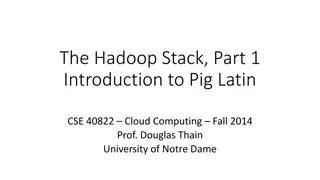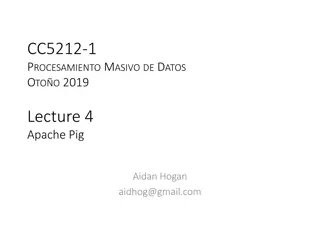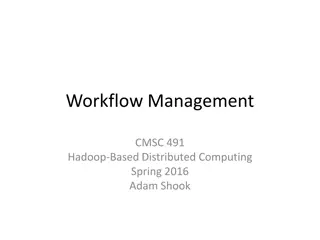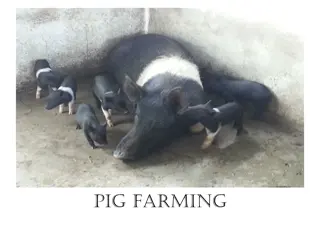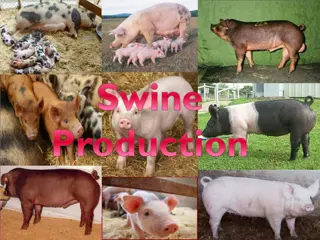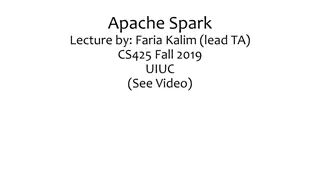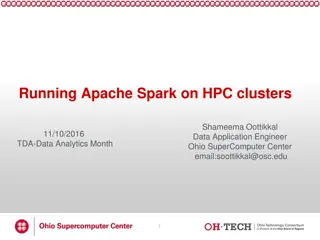Introduction to Apache Pig: A High-level Overview
Apache Pig is a data flow language developed by Yahoo! and is a top-level Apache project that enables non-Java programmers to access and analyze data on a cluster. It interprets Pig Latin commands to generate MapReduce jobs, simplifying data summarization, reporting, and querying tasks. Pig operates with different data types such as Atom, Tuple, Bag, and Map, offering support for grouping, joins, filtering, aggregation, and extensibility with user-defined functions. Pig can run in local or MapReduce modes, facilitating interactive or batch execution using Pig Latin scripts.
Download Presentation

Please find below an Image/Link to download the presentation.
The content on the website is provided AS IS for your information and personal use only. It may not be sold, licensed, or shared on other websites without obtaining consent from the author. Download presentation by click this link. If you encounter any issues during the download, it is possible that the publisher has removed the file from their server.
E N D
Presentation Transcript
Apache Pig Based on slides from Adam Shook
What Is Pig? Developed by Yahoo! and a top level Apache project Immediately makes data on a cluster available to non- Java programmers via Pig Latin a dataflow language Interprets Pig Latin and generates MapReduce jobs that run on the cluster Enables easy data summarization, ad-hoc reporting and querying, and analysis of large volumes of data Pig interpreter runs on a client machine no administrative overhead required
Pig Terms All data in Pig one of four types: An Atom is a simple data value - stored as a string but can be used as either a string or a number A Tuple is a data record consisting of a sequence of "fields" Each field is a piece of data of any type (atom, tuple or bag) A Bag is a set of tuples (also referred to as a Relation ) The concept of a kind of a table A Map is a map from keys that are string literals to values that can be any data type The concept of a hash map
Pig Capabilities Support for Grouping Joins Filtering Aggregation Extensibility Support for User Defined Functions (UDF s) Leverages the same massive parallelism as native MapReduce
Pig Basics Pig is a client application No cluster software is required Interprets Pig Latin scripts to MapReduce jobs Parses Pig Latin scripts Performs optimization Creates execution plan Submits MapReduce jobs to the cluster
Execution Modes Pig has two execution modes Local Mode - all files are installed and run using your local host and file system MapReduce Mode - all files are installed and run on a Hadoop cluster and HDFS installation Interactive By using the Grunt shell by invoking Pig on the command line $ pig grunt> Batch Run Pig in batch mode using Pig Scripts and the "pig" command $ pig f id.pig p <param>=<value> ...
Pig Latin Pig Latin scripts are generally organized as follows A LOAD statement reads data A series of transformation statements process the data A STORE statement writes the output to the filesystem A DUMP statement displays output on the screen Logical vs. physical plans: All statements are stored and validated as a logical plan Once a STORE or DUMP statement is found the logical plan is executed
Example Pig Script -- Load the content of a file into a pig bag named input_lines input_lines = LOAD 'CHANGES.txt' AS (line:chararray); -- Extract words from each line and put them into a pig bag named words words = FOREACH input_lines GENERATE FLATTEN(TOKENIZE(line)) AS word; -- filter out any words that are just white spaces filtered_words = FILTER words BY word MATCHES '\\w+'; -- create a group for each word word_groups = GROUP filtered_words BY word; -- count the entries in each group word_count = FOREACH word_groups GENERATE COUNT(filtered_words) AS count, group AS word; -- order the records by count ordered_word_count = ORDER word_count BY count DESC; -- Store the results ( executes the pig script ) STORE ordered_word_count INTO 'output ;
Basic grunt Shell Commands Help is available $ pig -h Pig supports HDFS commands grunt> pwd put, get, cp, ls, mkdir, rm, mv, etc.
About Pig Scripts Pig Latin statements grouped together in a file Can be run from the command line or the shell Support parameter passing Comments are supported Inline comments '--' Block comments /* */
Simple Data Types Type Description int 4-byte integer long 8-byte integer float 4-byte (single precision) floating point double 8-byte (double precision) floating point bytearray Array of bytes; blob chararray String ( hello world ) boolean True/False (case insensitive) datetime A date and time biginteger Java BigInteger bigdecimal Java BigDecimal
Complex Data Types Type Description Tuple Ordered set of fields (a row / record ) Bag Collection of tuples (a resultset / table ) Map A set of key-value pairs Keys must be of type chararray
Pig Data Formats BinStorage Loads and stores data in machine-readable (binary) format PigStorage Loads and stores data as structured, field delimited text files TextLoader Loads unstructured data in UTF-8 format PigDump Stores data in UTF-8 format YourOwnFormat! via UDFs
Loading Data Into Pig Loads data from an HDFS file var = LOAD 'employees.txt'; var = LOAD 'employees.txt' AS (id, name, salary); var = LOAD 'employees.txt' using PigStorage() AS (id, name, salary); Each LOAD statement defines a new bag Each bag can have multiple elements (atoms) Each element can be referenced by name or position ($n) A bag is immutable A bag can be aliased and referenced later
Input And Output STORE Writes output to an HDFS file in a specified directory grunt> STORE processed INTO 'processed_txt'; Fails if directory exists Writes output files, part-[m|r]-xxxxx, to the directory PigStorage can be used to specify a field delimiter DUMP Write output to screen grunt> DUMP processed;
Relational Operators FOREACH Applies expressions to every record in a bag FILTER Filters by expression GROUP Collect records with the same key ORDER BY Sorting DISTINCT Removes duplicates
FOREACH . . .GENERATE Use the FOREACH GENERATE operator to work with rows of data, call functions, etc. Basic syntax: alias2 = FOREACH alias1 GENERATE expression; Example: DUMP alias1; (1,2,3) (4,2,1) (8,3,4) (4,3,3) (7,2,5) (8,4,3) alias2 = FOREACH alias1 GENERATE col1, col2; DUMP alias2; (1,2) (4,2) (8,3) (4,3) (7,2) (8,4)
FILTER. . .BY Use the FILTER operator to restrict tuples or rows of data Basic syntax: alias2 = FILTER alias1 BY expression; Example: DUMP alias1; (1,2,3) (4,2,1) (8,3,4) (4,3,3) (7,2,5) (8,4,3) alias2 = FILTER alias1 BY (col1 == 8) OR (NOT (col2+col3 > col1)); DUMP alias2; (4,2,1) (8,3,4) (7,2,5) (8,4,3)
GROUP. . .ALL Use the GROUP ALL operator to group data Use GROUP when only one relation is involved Use COGROUP with multiple relations are involved Basic syntax: alias2 = GROUP alias1 ALL; Example: DUMP alias1; (John,18,4.0F) (Mary,19,3.8F) (Bill,20,3.9F) (Joe,18,3.8F) alias2 = GROUP alias1 BY col2; DUMP alias2; (18,{(John,18,4.0F),(Joe,18,3.8F)}) (19,{(Mary,19,3.8F)}) (20,{(Bill,20,3.9F)})
ORDER. . .BY Use the ORDER BY operator to sort a relation based on one or more fields Basic syntax: alias = ORDER alias BY field_alias [ASC|DESC]; Example: DUMP alias1; (1,2,3) (4,2,1) (8,3,4) (4,3,3) (7,2,5) (8,4,3) alias2 = ORDER alias1 BY col3 DESC; DUMP alias2; (7,2,5) (8,3,4) (1,2,3) (4,3,3) (8,4,3) (4,2,1)
DISTINCT. . . Use the DISTINCT operator to remove duplicate tuples in a relation. Basic syntax: alias2 = DISTINCT alias1; Example: DUMP alias1; (8,3,4) (1,2,3) (4,3,3) (4,3,3) (1,2,3) alias2= DISTINCT alias1; DUMP alias2; (8,3,4) (1,2,3) (4,3,3)
Relational Operators FLATTEN Used to un-nest tuples as well as bags INNER JOIN Used to perform an inner join of two or more relations based on common field values OUTER JOIN Used to perform left, right or full outer joins SPLIT Used to partition the contents of a relation into two or more relations SAMPLE Used to select a random data sample with the stated sample size
INNER JOIN. . . Use the JOIN operator to perform an inner, equi- join join of two or more relations based on common field values The JOIN operator always performs an inner join Inner joins ignore null keys Filter null keys before the join JOIN and COGROUP operators perform similar functions JOIN creates a flat set of output records COGROUP creates a nested set of output records
INNER JOIN Example DUMP Alias1; (1,2,3) (4,2,1) (8,3,4) (4,3,3) (7,2,5) (8,4,3) DUMP Alias2; (2,4) (8,9) (1,3) (2,7) (2,9) (4,6) (4,9) Join Alias1 by Col1 to Alias2 by Col1 Alias3 = JOIN Alias1 BY Col1, Alias2 BY Col1; Dump Alias3; (1,2,3,1,3) (4,2,1,4,6) (4,3,3,4,6) (4,2,1,4,9) (4,3,3,4,9) (8,3,4,8,9) (8,4,3,8,9)
OUTER JOIN. . . Use the OUTER JOIN operator to perform left, right, or full outer joins Pig Latin syntax closely adheres to the SQL standard The keyword OUTER is optional keywords LEFT, RIGHT and FULL will imply left outer, right outer and full outer joins respectively Outer joins will only work provided the relations which need to produce nulls (in the case of non-matching keys) have schemas Outer joins will only work for two-way joins To perform a multi-way outer join perform multiple two- way outer join statements
User-Defined Functions Natively written in Java, packaged as a jar file Other languages include Jython, JavaScript, Ruby, Groovy, and Python Register the jar with the REGISTER statement Optionally, alias it with the DEFINE statement REGISTER /src/myfunc.jar; A = LOAD 'students'; B = FOREACH A GENERATE myfunc.MyEvalFunc($0);
DEFINE DEFINE can be used to work with UDFs and also streaming commands Useful when dealing with complex input/output formats /* read and write comma-delimited data */ DEFINE Y 'stream.pl' INPUT(stdin USING PigStreaming(',')) OUTPUT(stdout USING PigStreaming(',')); A = STREAM X THROUGH Y; /* Define UDFs to a more readable format */ DEFINE MAXNUM org.apache.pig.piggybank.evaluation.math.MAX; A = LOAD student_data AS (name:chararray, gpa1:float, gpa2:double); B = FOREACH A GENERATE name, MAXNUM(gpa1, gpa2); DUMP B;
References http://pig.apache.org
Apache Hive Based on Slides by Adam Shook
What Is Hive? Developed by Facebook and a top-level Apache project A data warehousing infrastructure based on Hadoop Immediately makes data on a cluster available to non- Java programmers via SQL like queries Built on HiveQL (HQL), a SQL-like query language Interprets HiveQL and generates MapReduce jobs that run on the cluster Enables easy data summarization, ad-hoc reporting and querying, and analysis of large volumes of data
What Hive Is Not Hive, like Hadoop, is designed for batch processing of large datasets Not an OLTP or real-time system Latency and throughput are both high compared to a traditional RDBMS Even when dealing with relatively small data ( <100 MB )
Data Hierarchy Hive is organised hierarchically into: Databases: namespaces that separate tables and other objects Tables: homogeneous units of data with the same schema Analogous to tables in an RDBMS Partitions: determine how the data is stored Allow efficient access to subsets of the data Buckets/clusters For sub-sampling within a partition Join optimization
HiveQL HiveQL / HQL provides the basic SQL-like operations: Select columns using SELECT Filter rows using WHERE JOIN between tables Evaluate aggregates using GROUP BY Store query results into another table Download results to a local directory (i.e., export from HDFS) Manage tables and queries with CREATE, DROP, and ALTER
Primitive Data Types Type Comments TINYINT, SMALLINT, INT, BIGINT 1, 2, 4 and 8-byte integers BOOLEAN TRUE/FALSE FLOAT, DOUBLE Single and double precision real numbers STRING Character string TIMESTAMP Unix-epoch offset or datetime string DECIMAL Arbitrary-precision decimal BINARY Opaque; ignore these bytes
Complex Data Types Type Comments STRUCT A collection of elements If S is of type STRUCT {a INT, b INT}: S.a returns element a MAP Key-value tuple If M is a map from 'group' to GID: M['group'] returns value of GID ARRAY Indexed list If A is an array of elements ['a','b','c']: A[0] returns 'a'
HiveQL Limitations HQL only supports equi-joins, outer joins, left semi-joins Because it is only a shell for Map-Reduce, complex queries can be hard to optimise Missing large parts of full SQL specification: HAVING clause in SELECT Correlated sub-queries Sub-queries outside FROM clauses Updatable or materialized views Stored procedures
Hive Metastore Stores Hive metadata Default metastore database uses Apache Derby Various configurations: Embedded (in-process metastore, in-process database) Mainly for unit tests Local (in-process metastore, out-of-process database) Each Hive client connects to the metastore directly Remote (out-of-process metastore, out-of-process database) Each Hive client connects to a metastore server, which connects to the metadata database itself
Hive Warehouse Hive tables are stored in the Hive warehouse Default HDFS location: /user/hive/warehouse Tables are stored as sub-directories in the warehouse directory Partitions are subdirectories of tables External tables are supported in Hive The actual data is stored in flat files
Hive Schemas Hive is schema-on-read Schema is only enforced when the data is read (at query time) Allows greater flexibility: same data can be read using multiple schemas Contrast with an RDBMS, which is schema-on- write Schema is enforced when the data is loaded Speeds up queries at the expense of load times
Create Table Syntax CREATE TABLE table_name (col1 data_type, col2 data_type, col3 data_type, col4 datatype ) ROW FORMAT DELIMITED FIELDS TERMINATED BY ',' STORED AS format_type;
Simple Table CREATE TABLE page_view (viewTime INT, userid BIGINT, page_url STRING, referrer_url STRING, ip STRING COMMENT 'IP Address of the User' ) ROW FORMAT DELIMITED FIELDS TERMINATED BY '\t' STORED AS TEXTFILE;
More Complex Table CREATE TABLE employees ( (name STRING, salary FLOAT, subordinates ARRAY<STRING>, deductions MAP<STRING, FLOAT>, address STRUCT<street:STRING, city:STRING, state:STRING, zip:INT>) ROW FORMAT DELIMITED FIELDS TERMINATED BY '\t' STORED AS TEXTFILE;
External Table CREATE EXTERNAL TABLE page_view_stg (viewTime INT, userid BIGINT, page_url STRING, referrer_url STRING, ip STRING COMMENT 'IP Address of the User') ROW FORMAT DELIMITED FIELDS TERMINATED BY '\t' STORED AS TEXTFILE LOCATION '/user/staging/page_view';
More About Tables CREATE TABLE LOAD: file moved into Hive s data warehouse directory DROP: both metadata and data deleted CREATE EXTERNAL TABLE LOAD: no files moved DROP: only metadata deleted Use this when sharing with other Hadoop applications, or when you want to use multiple schemas on the same data
Partitioning Can make some queries faster Divide data based on partition column Use PARTITION BY clause when creating table Use PARTITION clause when loading data SHOW PARTITIONS will show a table s partitions
Bucketing Can speed up queries that involve sampling the data Sampling works without bucketing, but Hive has to scan the entire dataset Use CLUSTERED BY when creating table For sorted buckets, add SORTED BY To query a sample of your data, use TABLESAMPLE
Browsing Tables And Partitions Command Comments SHOW TABLES; Show all the tables in the database SHOW TABLES 'page.*'; Show tables matching the specification ( uses regex syntax ) SHOW PARTITIONS page_view; Show the partitions of the page_view table DESCRIBE page_view; List columns of the table DESCRIBE EXTENDED page_view; More information on columns (useful only for debugging ) DESCRIBE page_view PARTITION (ds='2008-10-31'); List information about a partition
Loading Data Use LOAD DATA to load data from a file or directory Will read from HDFS unless LOCAL keyword is specified Will append data unless OVERWRITE specified PARTITION required if destination table is partitioned LOAD DATA LOCAL INPATH '/tmp/pv_2008-06-8_us.txt' OVERWRITE INTO TABLE page_view PARTITION (date='2008-06-08', country='US')
Inserting Data Use INSERT to load data from a Hive query Will append data unless OVERWRITE specified PARTITION required if destination table is partitioned FROM page_view_stg pvs INSERT OVERWRITE TABLE page_view PARTITION (dt='2008-06-08', country='US') SELECT pvs.viewTime, pvs.userid, pvs.page_url, pvs.referrer_url WHERE pvs.country = 'US';
Loading And Inserting Data: Summary Use this For this purpose LOAD Load data from a file or directory INSERT Load data from a query One partition at a time Use multiple INSERTs to insert into multiple partitions in the one query CREATE TABLE AS (CTAS) Insert data while creating a table Add/modify external file Load new data into external table
